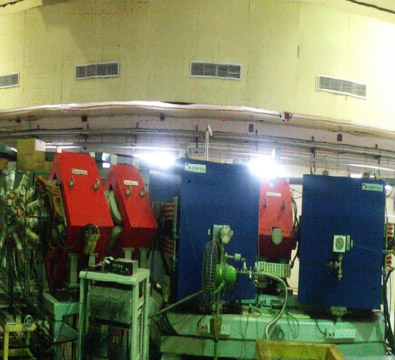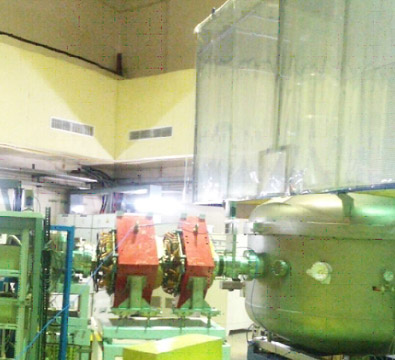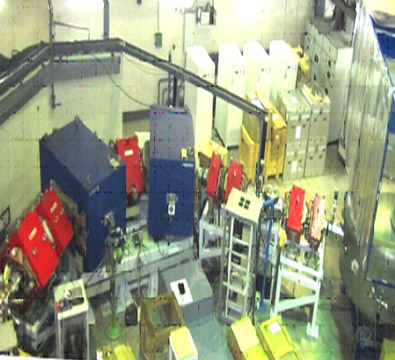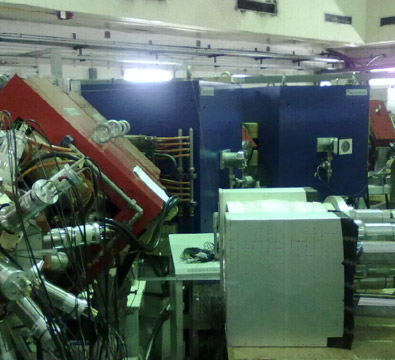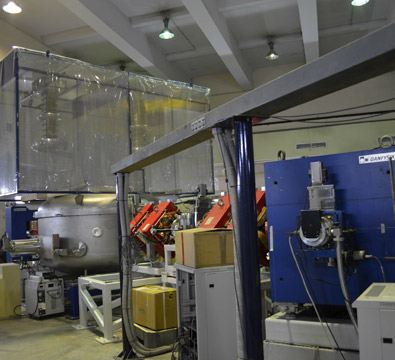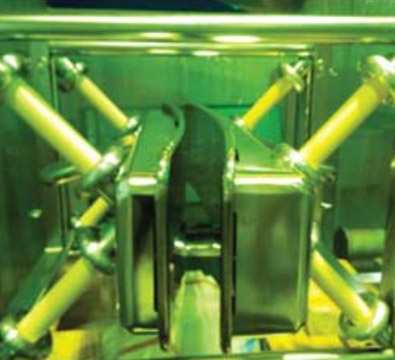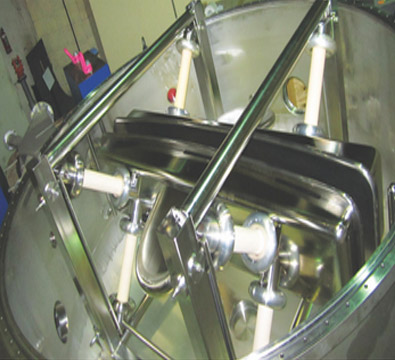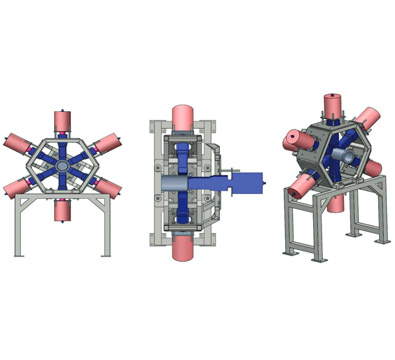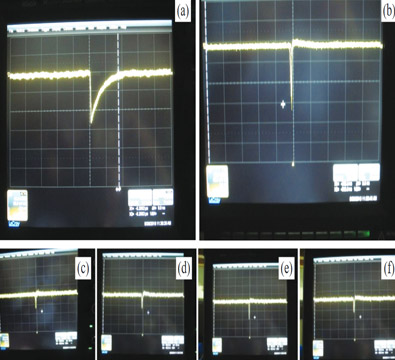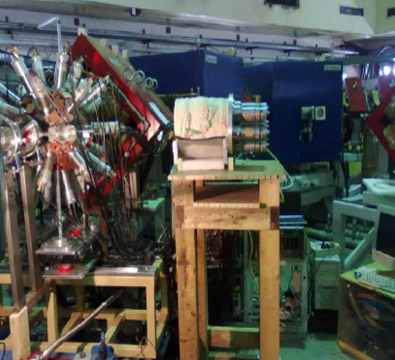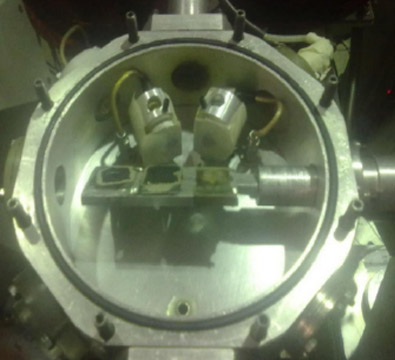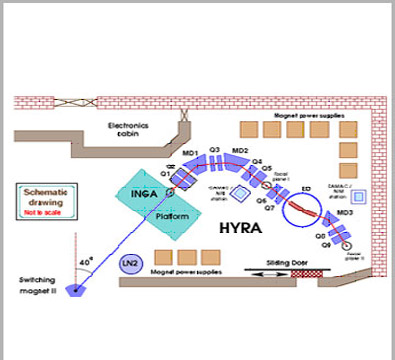
About HYbrid Recoil Mass Analyzer
HYbrid Recoil mass Analyzer (HYRA) is a dual mode, dual stage spectrometer / separator with its first stage capable of operating in gas-filled mode in normal kinematics (to access heavy nuclei surviving fission, around mass 200 amu and beyond) and both stages in vacuum mode in inverse kinematics (to access nuclei around N ~ Z up to 100 amu mass and to provide light, secondary beams produced in direct reactions). This unique device is commissioned in beam hall II, downstream of the superconducting linear accelerator (SC-LINAC) which can provide heavy ion beams of increased energy (almost doubling the beam energy available from 15UD Pelletron accelerator). The High Current Injector (HCI) being developed, will increase beam intensities by orders of magnitude so that most of the low cross section processes can be taken up.
The first stage of HYRA, consisting of Q1Q2-MD1-Q3-MD2-Q4Q5, is operable with momentum dispersion in gas-filled mode or as a momentum achromat in vacuum mode. The second stage consists of Q6Q7-ED-MD3-Q8Q9, which gives rise to mass dispersion by the cancellation of energy dispersion at a fixed focal point. Thus, the electromagnetic configuration of complete HYRA is Q1Q2-MD1-Q3-MD2-Q4Q5-Q6Q7-ED-MD3-Q8Q9.
To increase the solid angle acceptance of HYRA, a superconducting large aperture quadrupole doublet was being developed for Q1Q2 by the Cryogenics group at IUAC. However, it could not be taken to completion due to the quench-induced burning of coils. At present, a large aperture (diameter ~ 200 mm) Q4Q5 doublet is used in place of Q1Q2, and Q8Q9 doublet (aperture diameter ~ 150 mm)) is used in the Q4Q5 position. A room temperature, large aperture (diameter ~ 200 mm) quadrupole doublet is required to complete the second stage too.
HYRA (first stage) is being used, since 2009, mostly in gas-filled, momentum dispersive mode (and in an experiment in vacuum, momentum achromat mode) for a wide variety of nuclear physics experiments exploiting its ability to study weak reaction channels in the heavy mass region, in the direction of the primary beam. In the gas-filled mode, under optimized conditions of helium gas pressure and magnetic fields set for optimum average charge state of the reaction products, charge state and velocity focusing effects increase the transmission efficiency. Multiple scattering of the reaction products with the gas atoms plays spoilsport resulting in larger spot size on the focal plane detector and poorer momentum resolution. Thus, the use of two large magnetic dipoles increases the primary beam and target-like recoil rejection at the focal plane in a significant manner at the cost of a reduction in the transmission efficiency.
A computer program has been developed and implemented to calculate the average charge state of the simulated predominant reaction product using an empirical formula. Q1, Q2, and MD fields are arrived at using the average charge state and the energy of the reaction products at the center of MD1 while MD2, Q4, and Q5 fields are calculated using the average charge state and the energy of the reaction products at the center of MD2. Q3 field is arrived at by taking an average of charge states and energies at the center of MD1 and MD2. The optimization is carried out around the calculated magnetic fields by maximizing the focal plane counts of the reaction products normalized by the geometric mean of the elastic scattering counts in the two monitor detectors.
The first stage can be operated in gas-filled mode with a fraction of Torr helium gas pressure maintained inactive flow mode and controlled using an MKS mass flow system and Baratron gauge in an active feedback loop; a carbon foil, mounted ~ 325 mm upstream of the target, is usually used to separate the beamline vacuum and gas-filled region. The target chamber is made of aluminum, has an internal diameter of 120 mm and a vertical clearance of ~ 35 mm, and is provided with equally spaced eight ports compatible with 1.33” CF flange but used with Viton o-rings. The entrance and exit ports are attached to funnel-shaped tubes to match with the beamline and HYRA quadrupole Q1 through appropriate bellows. The bottom lid has accurately machined pedestals for two 50 mm2 monitor detectors to be mounted at equal angles on either side, for normalization and beam tuning/optimization purposes and also provision for introducing the helium gas. The target ladder has three slots and an additional fixed aperture just before the target prevents the beam from scattered from bon window foil from reaching the monitor detectors. A 4 mm x 4mm square aperture in a tantalum disk, mounted ~ 50 cm upstream of the target, helps in reducing the beam spot size on the target. Gas-filled mode helps in rejecting the beam scattered from the edges of the aperture. The use of gas in the separator helps in doing away with charge reset foil which is normally used after the target to overcome the charge changing effects of multiple Auger processes.
The focal plane detector system consists of a 150 mm x 50 mm MWPC detector followed by a position-sensitive silicon detector of size 50 mm x 50 mm. Isobutane gas (~ 2 Torr) is used and a large area, 0.5-micron thick Mylar foil is used to separate the helium and isobutane regions. Primary beam rejection of the order of 1012 or more for most reactions implies the energy loss signal in MWPC and the time of arrival of the particles at the focal plane is sufficient to identify and quantify the reaction products.
The TIFR 4 spin spectrometer, mounted around the target chamber for collaborative evaporation residue (ER) gated angular momentum distribution measurements, can be separated into two halves sideways, precisely, using linear rails. It consists of 20 hexagonal and 12 pentagonal NaI detectors forming a closed geometry. Two pentagons are removed for beam entrance and beam/reaction product exit and a hexagon is removed to fit in the target ladder actuator. Gamma multiplicity and ‘OR’ signal are used to extract the angular momentum of ER and to establish coincidence with ERs at the focal plane, respectively.
Some of the studies being pursued or planned are:
- Heavy ion-induced fusion reactions around the Coulomb barrier (A>150 amu)
- Fission hindrance through spin dependence of heavy ERs (HYRA + TIFR 4 spin spectrometer)
- Residue-tagged γ-spectroscopy (using planned Heavy Ion Mass Analyzer coupled to Large gAmma arraY (HIMALAY) also known as HYRA-INGA combined facility)
- Quasi-elastic scattering or Transfer reaction around Coulomb barrier by detecting heavy target-like recoils using gas-filled mode (proof of principle tested)
- Microsecond isomer decay at the focal plane (with one or many germanium clover detectors
- Experiments using secondary beam produced with first stage of HYRA in vacuum, momentum achromat mode and analysed using the second stage
Features

- The first stage is a momentum achromat stage with two large magnetic dipole magnets of 1.5 m radius and 1.5 T maximum field (i.e. Maximum magnetic rigidity = 2.25 T-m).
- The lower radius and higher radius sides of MD1 chamber are lined with tantalum with water-cooled copper backing to stop the primary beam in gas-filled mode and vacuum mode operation, respectively.
- A large beam catcher made of Molybdenum and backed by water-cooled copper can stop the primary beam and measure the unsuppressed current when MD1 is off.
- The quadrupole Q3, between MD1 and MD2, is split into two halves with the intermediate space provided for the insertion of slits or beam stoppers depending on the mode of operation.
- The entrance and exit of Q3 chamber are provided with welded bellows to allow the sideways movement of Q3 in a precise and reproducible manner on linear rails. The space thus created may be used as focal plane position in gas-filled mode for better transmission of low velocity, heavy ERs.
- Gas-filled mode does not require charge reset foil after the target as the collissions in the gas medium effectively reset the charge states of ERs after multiple Auger processes.
- Primary beam rejection of better than 1012 has been measured for ER detection formed through fusion of 16O + 194Pt system.
- Transmission efficiency of HYRA gas-filled mode for ERs (initial energy ~ 75 MeV) from fusion reactions induced by 48Ti on targets of mass ~ 150 amu have been measured to be ~ 28 % for a flight path of ~ 7.5 m.
- The comparison of ungated and ER-gated higher folds of gamma detection has been used in a novel way to extract the average transmission efficiency of HYRA gas-filled mode for ERs.
- Quadrupole magnets Q6 and Q7 are provided with sideways movement mechanism for creating extra space around the first focal plane to install HPGe / Clover detectors for microsecond isomer decay studies.
- The electrostatic dipole (ED) of the second stage has curved anode and cathode plates machined from solid titanium and is capable of reaching voltages of +/- 300 kV across a gap of 12 cm.
- Two dedicated focal plane detector systems are planned for the two modes of operation.
Research
- Heavy ion-induced fusion reactions around the Coulomb barrier (A>150 amu)
- Fission hindrance and nuclear viscosity through spin dependence of heavy ERs
- Microsecond isomer decay (around Z=82 and N = 126) at the focal plane
- Clustering vs. Pairing effects in light nuclei
- Residue-tagged γ-spectroscopy (after HYRA and INGA are coupled together)
- Quasi-elastic scattering or Transfer reactions around Coulomb barrier by detecting heavy target-like recoils at 0o using gas-filled mode
- ER and spin gated GDR measurements (with high intensity beams from planned HCI)
- Experiments using secondary beam produced with first stage of HYRA in vacuum, momentum achromat mode and analysed using the second stage (with high intensity beams from planned HCI).
People
Staff Telephone: +91 11 24126018, 24126022, 24126024-26, 24126029 Telefax: +91 11 24126036, 24126041
Research Scholars (Pursuing and beam time taken)
-
K. Hajara
Calicut University, Calicut, Kerala
-
D. P. Kaur
Panjab University Chandigarh, India
-
P. Sandya Devi
Andhra University, Visakhapatnam, India
Alumni
-
M. M. Hosamani
Karnatak University, Dharwad, India
-
Rajesh K. K.
Calicut University, Calicut, Kerala
-
A. Shamlath
Central University of Kerala, Kasaragod, Kerala
-
Priya Sharma
Panjab University, Chandigarh, India
-
Laveen P. V
Central University of Kerala, Kasaragod, Kerala
-
T. Roy
Variable Energy Cyclotron Centre, Kolkata, India
-
Rohit Sandal
Panjab University, Chandigarh, India
-
V. Singh
Panjab University, Chandigarh, India
-
G. Mohanto
Inter-University Accelerator Centre, New Delhi, India
-
E. Prasad
Calicut University, Calicut, Kerala
Publication
-
Evaporation-residue-gated spin distribution measurements of the highly fissile compound nucleus 224 Th through 16 O + 208 Pb and 18 O + 206 Pb reactions
M. M. Hosamani, N. M. Badiger, N. Madhavan, I. Mazumdar, S. Nath, J. Gehlot, A. K. Sinha, S. M. Patel, P. B. Chavan, T. Varughese, Vishal Srivastava, Md. Moin Shaikh, P. Sandya Devi, P. V. Laveen, A. Shamlath, M. Shareef, S. K. Duggi, P. V. Madhusudhana Rao, G. Naga Jyothi, A. Tejaswi, P. N. Patil, A. Vinayak, K. K. Rajesh, Abhishek Yadav, A. Parihari, Rohan Biswas, Monalisha Dhibar, D. P. Kaur, M. Ratna Raju, and J. Joseph Phys. Rev. C 101, 014616 (2020)
-
Evaporation residue cross-section measurements for 16 O + 203,205 Tl
J. Gehlot, A. M. Vinodkumar, N. Madhavan, S. Nath, A. Jhingan, T. Varughese, Tathagata Banerjee, A. Shamlath, P. V. Laveen, M. Shareef, P. Jisha, P. Sandya Devi, G. Naga Jyothi, M. M. Hosamani, I. Mazumdar, V. I. Chepigin, M. L. Chelnokov, A. V. Yeremin, A. K. Sinha, and B. R. S. Babu Phys. Rev. C 99, 034615 (2019)
-
Measurement of fusion evaporation residue cross-sections in the 48 Ti + 138 Ba reaction
K. K. Rajesh, M. M. Musthafa, N. Madhavan, S. Nath, J. Gehlot, Jhilam Sadhukhan, P. Mohamed Aslam, P. T. Muhammed shan, E. Prasad, M. M. Hosamani, T. Varughese, Abhishek Yadav, Vijay R. Sharma, Vishal Srivastava, Md. Moin Shaikh, M. Shareef, A. Shamlath, and P. V. Laveen Phys. Rev. C 100, 044611 (2019)
-
Evaporation residue cross-section measurements for 48Ti-induced reactions
Priya Sharma, BR Behera, Ruchi Mahajan, Meenu Thakur, Gurpreet Kaur, Kushal Kapoor, Kavita Rani, N Madhavan, S Nath, J. Gehlot, R Dubey, I Mazumdar, SM Patel, M Dhibar, MM Hosamani, Neeraj Kumar, A Shamlath, G Mohanto, Santanu Pal, Phys. Rev. C 96, 034613 (2017)
-
Fusion and quasifission studies in reactions forming Rn via evaporation residue measurements
A Shamlath, E Prasad, N Madhavan, PV Laveen, J. Gehlot, AK Nasirov, G Giardina, G Mandaglio, S Nath, Tathagata Banerjee, AM Vinodkumar, M Shareef, AJhingan, T Varughese, DVGRKS Kumar, P Sandya Devi, P Jisha, Neeraj Kumar, MM Hosamani, S Kailas Phys. Rev. C 95, 034610 (2017)
-
Spin distributions and cross-sections of evaporation residues in the reaction
K Sudarshan, R Tripathi, S Sodaye, SK Sharma, PK Pujari, J. Gehlot, N Madhavan, S Nath, G Mohanto, I Mukul, A Jhingan, I Mazumdar Phys. Rev. C 95, 024604 (2017)
-
Probing nuclear dissipation via evaporation residue excitation functions for the 16,18O + 198Pt reactions
Rohit Sandal, BR Behera, Varinderjit Singh, Maninder Kaur, A Kumar, Gurpreet Kaur, P Sharma, N Madhavan, S Nath, J. Gehlot, A Jhingan, KS Golda, Hardev Singh, S Mandal, S Verma, E Prasad, KM Varier, AM Vinodkumar, A Saxena, Jhilam Sadhukhan Santanu Pal Phys. Rev. C 91, 044621 (2015)
-
Fusion measurements for the 18O + 194Pt reaction and search for neutron shell closure effects
PV Laveen, E Prasad, N Madhavan, S Pal, J Sadhukhan, S Nath, J. Gehlot, A Jhingan, KM Varier, RG Thomas, AM Vinodkumar, A Shamlath, T Varughese, P Sugathan, BRS Babu, S Appannababu, KS Golda, BR Behera, Varinderjit Singh, Rohit Sandal, A Saxena, BV John, S Kailas J. Phys. G: Nucl. Part. Phys. 42, 095105 (2015)
-
A new high-spin isomer in 195Bi
T Roy, G Mukherjee, N Madhavan, TK Rana, Soumik Bhattacharya, Md A Asgar, I Bala, K Basu, SS Bhattacharjee, C Bhattacharya, S Bhattacharya, S Bhattacharyya, J. Gehlot, SS Ghugre, RK Gurjar, A Jhingan, R Kumar, S Muralithar, S Nath, H Pai, R Palit, R Raut, RP Singh, AK Sinha, T Varughese, Eur. Phys. J. A 51, 153 (2015)
-
Recent results of measurements of evaporation residue excitation functions for 19F+194,196,198Pt and 16,18O+198Pt systems with HYRA spectrometer at IUAC
B.R. Behera, EPJ Web Conferences, 86, 00003 (2015)
-
Statistical model calculations for evaporation residue and fission cross-section for 48Ti+ 122Sn system
Priya Sharma, B. R. Behera, Santanu Pal and N. Madhavan, EPJ Web Conferences, 86, 00045 (2015)
-
Fission excitation function for 19F+194,196,198Pt at near and above barrier energies
Varinderjit Singh, B. R. Behera, Maninder Kaur, A. Jhingan, P. Sugathan, Santanu Pal, Davinder Siwal, M. Oswal, K. P. Singh, S. Goyal, A. Saxena and S. Kailas, EPJ Web Conferences, 86, 00052 (2015)
-
Measurement of evaporation residue excitation functions for the 19F194,196,198Pt reactions
Varinderjit Singh, BR Behera, Maninder Kaur, A Kumar, KP Singh, N Madhavan, S Nath, J. Gehlot, G Mohanto, A Jhingan, Ish Mukul, T Varughese, Jhilam Sadhukhan, Santanu Pal, S Goyal, A Saxena, S Santra, S Kailas Phys. Rev. C 89, 024609 (2014)
-
Evaporation residue excitation function and spin distribution for 31P + 170Er
G Mohanto, N Madhavan, S Nath, J. Gehlot, Ish Mukul, A Jhingan, T Varughese, A Roy, RK Bhowmik, I Mazumdar, DA Gothe, PB Chavan, J Sadhukhan, S Pal, Maninder Kaur, Varinderjit Singh, AK Sinha, VS Ramamurthy Phys. Rev. C 88, 034606 (2013)
-
Entrance channel effect on ER spin distribution
Gayatri Mohanto, N. Madhavan, S. Nath, Jhilam Sadhukhan, J. Gehlot, I. Mazumdar, M. B. Naik, E. Prasad, Ish mukul, T. Varughese, A. Jhingan, R.K. Bhowmik, A.K. Sinha, D.A. Gothe, P.B. Chavan, Santanu Pal, V.S. Ramamurthy, A. Roy Nucl. Phys. A 890-891 (2012) 62-76
-
Evaporation residue excitation function measurement for the 16O + 194Pt reaction
E. Prasad, K.M. Varier, N. Madhavan, S. Nath, J. Gehlot, Sunil Kalkal, Jhilam Sadhukhan, G. Mohanto, P. Sugathan, A. Jhingan, B. R. S. Babu, T. Varughese, K. S. Golda, B. P. Ajith Kumar, B. Satheesh, Santanu Pal, R. Singh, A. K. Sinha, and S. Kailas Phys. Rev. C 84, 064606 (2011)
-
ER cross section measurement in 16 O + 194 Pt reaction using gas-filled mode of HYRA
E. Prasad, K.M. Varier, N. Madhavan, S. Nath, J. Gehlot, Sunil Kalkal, Jhilam Sadhukhan, G. Mohanto, P. Sugathan, A. Jhingan, B.R.S. Babu, T. Varughese, K.S. Golda, B.P. Ajith Kumar, B. Satheesh, Santanu Pal, R. Singh, A. K. Sinha, and S. Kailas EPJ Web of Conferences 17, 16011 (2011)
-
Entrance channel effect for CN 200 Pb
Gayatri Mohanto, N. Madhavan, S. Nath, J. Gehlot, M. B. Naik, E. Prasad, Ish Mukul, T. Varughese, A. Jhingan, R.K. Bhowmik, A.K. Sinha, I. Mazumdar, D.A. Gothe, P.B. Chavan, Santanu Pal, and V.S. Ramamurthy EPJ Web of Conferences 17, 16007 (2011)
-
HYRA gas-filled separator coupled to 4π spin spectrometer at IUAC, New Delhi
N. Madhavan, I. Mazumdar, T. Varughese, J. Gehlot, S. Nath, M. B. Naik, I. Mukul, and A. K. Sinha EPJ Web of Conferences 17, 14003 (2011)
-
Hybrid recoil mass analyzer at IUAC–First result using gas-filled mode and plans
N. Madhavan, S. Nath, T. Varughese, J. Gehlot, A. Jhingan, P. Sugathan, A. K. Sinha, R. Singh, K. M. Varier, M. C. Radhakrishna, E. Prasad, S. Kalkal, G. Mohanto, J. J. Das, Rakesh Kumar, R. P. Singh, S. Muralithar, R. K. Bhowmik, A. Roy, Rajesh Kumar, S. K. Suman, A. Mandal, T. S. Datta, J. Chacko, A. Choudhury, U. G. Naik, A. J. Malyadri, M. Archunan, J. Zacharias, S. Rao, Mukesh Kumar, P. Barua E. T. Subramanian, K. Rani, B. P. Ajithkumar, and K. S. Golda PRAMANA-journal of physics, Vol. 75, No. 2 (2010) pp.. 317–331








